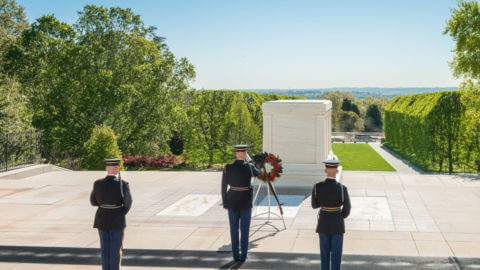The Tomb of the Unknown Soldier

In 1921, Congress approved the burial of one unknown serviceman killed during World War I in the plaza of the newly built Memorial Amphitheater. To ensure that the choice was truly random amongst the options, four service members were exhumed from four separate cemeteries in France. Army Sergeant Edward Younger, a recipient of the Distinguished Service Cross, was selected to pick one of the four identical caskets. He placed a spray of white roses on the third casket from the left. While the chosen soldier was transported back from France on the USS Olympia, the others were reburied in the Meuse Argonne Cemetery.
The unknown remains were interred beneath a three-tiered, marble tomb.
President Harding presided over the interment ceremony on Veterans Day that same year.
The Yule marble memorial sarcophagus was completed in 1932 with the addition of the 79-ton superstructure on top of the original tomb. Because of imperfections, the painstaking process of creating the seven marble blocks for the sarcophagus required several quarrying attempts and lasted a year. The marble came from the same quarry used for the Lincoln Memorial. The four-tiered tomb consists of a base, a sub-base, a cap and a die, which is the largest of the blocks. The facade of the superstructure is adorned with various engravings. The north and south panels have three wreaths, the east panel depicts Greek mythological figures that symbolize peace, victory and valor and the west panel is inscribed with the epitaph that the American soldier is “known only to God.”
The engravings were created by the Piccirilli Brothers who also carved the statue of Abraham Lincoln inside the Lincoln Memorial.




